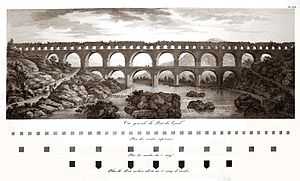Charles-Louis Clérisseau

Charles-Louis Clérisseau (28 August 1721 – 9 January 1820) was a French architectural draughtsman, antiquary and artist. He had a role in the genesis of neoclassical architecture during the second half of the 18th century.
Born in Paris, he was a pupil of the painter of ruins Giovanni Paolo Pannini and a former student at the French Academy in Rome, which he left in 1754 after a dispute with its director, Natoire. In 1755 the Scottish architect Robert Adam arrived in Florence, where he met Clérisseau, who accompanied him to Rome; there Adam resolved, under the spell of Clérisseau, to produce a volume for publication upon his return that would establish him as a serious architect. The project he selected was a volume documenting the ruins of Diocletian's Palace at Split, easily accessible on the Dalmatian coast. Over a period of five weeks in 1757 Adam sketched and supervised the documentation of the ruins, while Clérisseau produced perspectives, and two German draftsmen undertook the measured drawings. Most of the published engravings in Adam's Ruins of the palace of the Emperor Diocletian at Spalato (1764) are believed to be the work of Clérisseau, though he received no credit.

Clérisseau passed most of the next decades in Rome. As it had done since the High Renaissance, ancient Rome and modern Rome functioned as a cultural hub, the ruins of Classical Antiquity providing a school in themselves, if one had a knowledgeable guide. Clérisseau served as a mentor to a generation of young architectural students who had won the prestigious Prix de Rome for study at the French Academy in Rome and guided the developing taste for the Antique in young French and British artists and gentlemen amateurs on the Grand Tour. In particular, his skillful drawings of ancient architectural details, of real Roman ruins and imaginary ones, helped form the taste of young architects like Robert Adam in the 1750s and his brother James Adam, in 1760-63. Clérisseau supported himself by providing architectural views, sometimes in series, for young men on the Grand Tour.[1]
Returning to Paris, Clérisseau was a magnet for young neoclassical architects, like François-Joseph Bélanger, who never went to Rome. In 1774, Clérisseau provided the designs for Jean-François Peyron's decors in the salon of the Hôtel Grimod de La Reynière, Paris, the earliest revival of grotesques in France. From 1785-89, he assisted Thomas Jefferson, in producing designs for the Virginia State Capitol. At the time, Jefferson was residing in Paris, while serving as American Minister to France. In 1788, the first (and only) volume in Clérisseau's intended series, Antiquités de la France, was published in Paris. Subtitled, "Monumens de Nismes", the folio included detailed engravings of the Maison Carrée, the building that inspired Clérisseau's collaboration with Thomas Jefferson on the design for the Virginia State Capitol. Mistakenly believing it to be a Republican period building, Jefferson admired the Maison Carrée (19-16 BCE) as "one of the most beautiful, if not the most beautiful and precious morsel of architecture left us by antiquity...." (quoted in McCormick, 1990).
The largest cache of Clérisseau drawings by far is in the collection at the State Hermitage Museum, St. Petersburg. Another large group is conserved at the Fitzwilliam Museum, Cambridge.
Notes
- ↑ Skinner, Basil (April 1963). "Nineteen Drawings by C. L. Clérisseau". The Burlington Magazine 105 (721): pp.160, 162. Some of these drawings, for two sons of the 2nd Earl of Hopetoun, are drawn in colour over engravings, a technique that must have sped production.
References
- Clérisseau, Charles-Louis (1778). Antiquités de la France, Prèmiere partie: Monumens de Nismes. Paris: P.D. Pièrres.
- Fleming, John (1962). Robert Adam and His Circle, in Edinburgh & Rome.
- Gallet, Michel (1995). Les architectes parisiens du XVIIIe siècle. Paris: Editions Mengès. pp. 127–134. ISBN 2-85620-370-1.
- McCormick, Thomas J. (1990). Charles-Louis Clérisseau and the Genesis of Neoclassicism. Cambridge and London: MIT Press/The Architectural History Foundation.
|